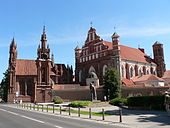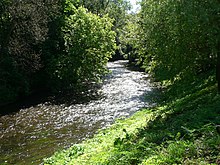Église St. Anne

|
| St. Anna in Vilna |
|---|
| Marianne von Werefkin , 1914 |
| Tempera on cardboard |
| 99.5 x 85 cm |
| Fondazione Marianne Werefkin , Museo comunale d'arte, Ascona |
Église St. Anne is the title of a painting that the Russian artist Marianne von Werefkin painted in 1913/14. The work belongs to the holdings of the Fondazione Marianne Werefkin (FMW) in Ascona . It bears the inventory number FMW-0-0-31 there.
Technology and dimensions
The painting is a tempera painting on cardboard , 99.5 × 85 cm.
iconography
“Église St. Anne” was shown in the first Werefkin exhibition in Germany after the Second World War. It was organized by Clemens Weiler in the Wiesbaden Museum. The painting shows a wintry view of Vilnius , the capital of the former Russian governorate of the same name in Lithuania .
The painting is dominated by a brick church with four large lancet windows , the wall parts of the side aisle of which are supported by pilasters . A tower still stands in the east today. It is the monastery church of St. Francis and Bernard from the 16th century. The building used to be surrounded by a simple wall. On the right side of the picture Werefkin knew a big yellow house. This is cut off from the picture frame, as is the last churchgoer from the left edge of the picture. In the same way, the tops of the church are cut from the upper picture frame. Letting people and objects collide with the picture frame is a stylistic relic from Japanese woodcut art , which the Werefkin had been familiar with since 1902 at the latest from Mir Iskusstwa and which she had used in her painting since 1907.
The eponymous Gothic St. Anna Church shows the painter on the left side of the picture almost lost in the background. Of the two building complexes, it is the much more important church in terms of art history. On site it is said that when Napoleon saw it on the march to Moscow in 1812 , he was so impressed by its architecture that he wanted to have it dismantled in Vilnius in order to have it rebuilt in Paris. Napoleon could not prevent the looting of the interior of the church by soldiers on the retreat of his defeated Grande Armée .
At the top left of the picture Werefkin shows a mountain with a tower, the symbol of Vilna. This is named after the Lithuanian Grand Duke Gediminas , who had a castle built at this height before he made Vilnius the new capital of Lithuania in 1323 as the successor to the medieval Trakai . The tower, which was restored from 1956 to 1960, is the remnant of a larger walled building complex with a castle. Werefkin's painting shows that the fortifications had already disappeared in their time.
At the bottom of the picture, Werefkin shows the river Vilnia , which Gediminas gave its name to the capital. The banks of the river are secured by a kind of pasture fence , which is more like a railing due to the high snowfall . In the left middle distance churchgoers trudging in single file through the snow to the door of the Church of St. Francis and St. Bernard to. They are led by altar boys who at long rods hangings carried before it. They are followed by the Catholic priest, who is dressed in a black, ankle-length cassock and a white choir shirt . He wears a black biretta on his head . In the picture of the Werefkin, five women with white headscarves in black, but also colored clothes, form the end of the procession . The appropriate title of the painting should actually be “Procession to the Church of Saints Francis and Bernhard” .
Dating
The FMW has a drawing for the painting in sketchbook e 19, which, however, does not contain a note or a date. However, since the picture characterizes a certain season of the year with a snowy landscape and blown snow on the roofs, a date with winter 1913/14 is indicated. In general, Werefkin's painting with the three most prominent buildings in the city is seen as a kind of homage to Vilna. Werefkin painted pictures with snow when she had already left Jawlensky in Munich and spent the winter of 1909/10 in Kownow with her brother Peter, who was then governor there. Werefkin's next winter stay in Lithuania was in Vilnius in 1913/14, where her brother Peter was appointed "Governor General of Vilnius, Grodno and Kovno" in 1912 . In addition, he had been given command of the Vilnius Military District and the 3rd Army Corps. In the middle of 1914 Werefkin decided to return to her adopted home in Munich. Shortly before the outbreak of the First World War, "literally at the last minute, on July 26th of that year, the Baroness returned to Giselastrasse."
literature
- Clemens Weiler : Marianne von Werefkin. In exh. Cat .: Marianne Werefkin 1860-1938. Municipal Museum Wiesbaden 1958, cat.no.46, undated (p. 10)
- Bernd Fäthke: Marianne Werefkin. Munich 2001, p. 194, fig. 216, ISBN 3-7774-9040-7
- Brigitte Roßbeck: Marianne von Werefkin, The Russian from the circle of the Blue Rider. Munich 2010.
- Bernd Fäthke : Marianne Werefkin: Clemens Weiler's Legacy. In: Marianne Werefkin and the Women Artists in her Circle. (Tanja Malycheva and Isabel Wünsche eds.), Leiden / Boston 2016 (English), pp. 8–19, ISBN 978-9-0043-2897-6
Individual evidence
- ↑ Clemens Weiler: Marianne von Werefkin. In exh. Cat .: Marianne Werefkin 1860-1938. Municipal Museum Wiesbaden 1958, cat.no.19, undated (p. 8)
- ↑ Bernd Fäthke: Von Werefkins and Jawlensky's weakness for Japanese art. In: exhib. Cat .: "... the tender, spirited fantasies ...", the painters of the "Blue Rider" and Japan. Murnau Castle Museum 2011, p. 108 f, Fig. 8 and 9
- ↑ Bernd Fäthke: Marianne Werefkin. Munich 2001, p. 13, ISBN 3-7774-9040-7
- ^ Meyers: Large conversation lexicon. A reference book of general knowledge. Leipzig and Vienna 1909, vol. 20, p. 656.
- ^ Brigitte Roßbeck: Marianne von Werefkin. The Russian from the Blue Rider's circle. Munich 2010, p. 177.



